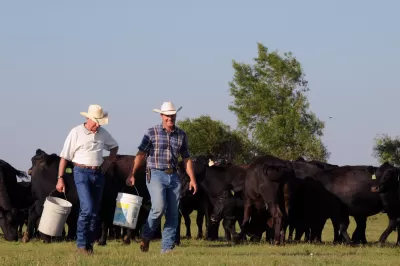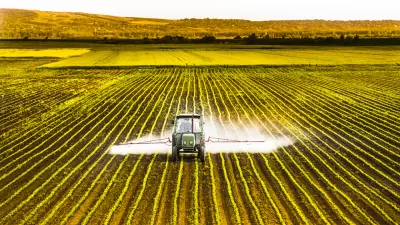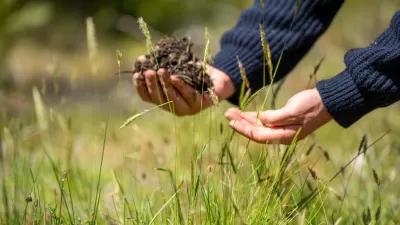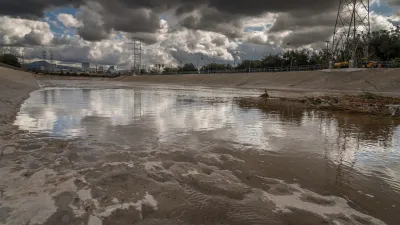With world population to grow by about 2 billion by 2050, and with more people eating higher on the food chain as nations develop economically, can world agriculture reduce its carbon footprint? A new World Resources Institute report shows how.

“Food is the mother of all sustainability challenges,” says Janet Ranganathan, vice president for science and research at the World Resources Institute (WRI), a global research organization. “We can’t get below 2 degrees Celsius without major changes to this system.”
She says that’s why the group’s report, Creating A Sustainable Food Future, released Dec. 5, 2018, is “one of the most important...that we’ve ever published," reports Jenny Splitter for Forbes.
Its authors set out to answer the most critical question facing the global food system today: how to feed the nearly 10 billion people expected to populate the earth by 2050 [up from almost 7.7 billion people today] in a way that doesn’t completely wreck the planet.
"Agriculture already occupies roughly 40 percent of the world’s land and is responsible for about a quarter of humanity’s greenhouse gas emissions," adds Brad Plumer for The New York Times's climate team in his piece on the WRI report.
"Increasing the amount of food produced per hectare was the most critical step, the experts said, followed by cutting meat-eating and putting a stop to the wasting of one-third of food produced," reports Damian Carrington, the Guardian's environment editor.
Chicken is not meat, or at least not "ruminant meat"
Restricting meat-eating need not mean becoming a vegetarian, though Carrington did pen a column on Dec. 22, "Why I’m looking forward to my first vegan Christmas."
“We could imagine a significant shift from beef to chicken, and that by itself goes a long way," said lead author Timothy D. Searchinger of Princeton University. “Poultry production has about one-eighth the climate impact of beef production," adds Plumer.
"According to Searchinger, WRI is recommending 'that two million heavy consumers of meat, lamb and goat in 2050 in the U.S., Russia, Europe, and Brazil, limit their consumption to 1.5 servings per person per week,' so the world can meet its overall reduction goals while, at the same time, acknowledging that 'the world’s poor people are entitled to consume at least a little more',” adds Splitter.
"Ruminant livestock (cattle, sheep, and goats) use two-thirds of global agricultural land and contribute roughly half of agriculture’s production-related emissions," states the executive summary [pdf]. "Ruminant meat demand is projected to grow by 88 percent between 2010 and 2050."
"Avoiding meat and dairy is ‘single biggest way’ to reduce your impact on Earth," reported Carrington of the Guardian on a study published in Science on June 1 that corroborated the outsized impacts of ruminants.
Not by efficiency alone
While efficiency—producing more food on less land, was the report's most critical finding, it recommended tying it to conservation, notes Splitter.
In order to protect natural resources even as farms become more efficient, Searchinger says “governments need to explicitly link...yield gains to protection of forests and other natural lands.” Through government regulation, natural ecosystems can be protected and agricultural expansion, when necessary, can be limited to avoid sacrificing resource-rich lands like tropical rainforests."
The report also looked at human population growth to reduce food demand "by reducing fertility levels, voluntarily, through 'improving education for girls, reducing child mortality and providing access to reproductive health services'," adds Splitter. Presumably this recommendation would be applicable to developing nations in Africa which have the world's highest fertility rates, unlike many economically developed nations where they have fallen below replacement levels.
FULL STORY: How To Feed The World Sustainably? Grow More With Less, New Study Finds

Planetizen Federal Action Tracker
A weekly monitor of how Trump’s orders and actions are impacting planners and planning in America.

Maui's Vacation Rental Debate Turns Ugly
Verbal attacks, misinformation campaigns and fistfights plague a high-stakes debate to convert thousands of vacation rentals into long-term housing.

San Francisco Suspends Traffic Calming Amidst Record Deaths
Citing “a challenging fiscal landscape,” the city will cease the program on the heels of 42 traffic deaths, including 24 pedestrians.

Amtrak Rolls Out New Orleans to Alabama “Mardi Gras” Train
The new service will operate morning and evening departures between Mobile and New Orleans.

The Subversive Car-Free Guide to Trump's Great American Road Trip
Car-free ways to access Chicagoland’s best tourist attractions.

San Antonio and Austin are Fusing Into one Massive Megaregion
The region spanning the two central Texas cities is growing fast, posing challenges for local infrastructure and water supplies.
Urban Design for Planners 1: Software Tools
This six-course series explores essential urban design concepts using open source software and equips planners with the tools they need to participate fully in the urban design process.
Planning for Universal Design
Learn the tools for implementing Universal Design in planning regulations.
Heyer Gruel & Associates PA
JM Goldson LLC
Custer County Colorado
City of Camden Redevelopment Agency
City of Astoria
Transportation Research & Education Center (TREC) at Portland State University
Jefferson Parish Government
Camden Redevelopment Agency
City of Claremont





























